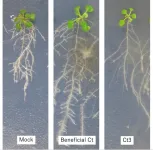(Press-News.org) As drinking water flows through pipes and into a glass, it runs against the rubber seals inside some plumbing devices. These parts contain additives that contribute to their flexibility and durability, but these potentially harmful compounds can leak into drinking water, according to a small-scale study in ACS’ Environmental Science & Technology Letters. The authors report that the released compounds, which are typically linked to tire pollution, also transformed into other unwanted byproducts.
To enhance rubber’s strength and durability, manufacturers typically mix in additives. Scientists have shown that tire dust can transport these substances, such as 1,3 diphenylguanidine (DPG) and N-(1,3-dimethylbutyl)-N'-phenyl-1,4-benzenediamine (6PPD), into waterways. DPG and 6PPD have also been detected in drinking water samples, though it’s unclear how the compounds got there. In previous research, Shane Snyder and Mauricius Marques dos Santos found that these rubber additives can react with disinfectants in simulated drinking water. Their lab tests generated a variety of chlorinated compounds, some of which could damage DNA. Now, the team wanted to assess whether real-world rubber plumbing fixtures can release DPG and 6PPD and form chlorinated byproducts in drinking water samples.
In this pilot study, the team collected tap water from 20 buildings and detected polymer additives at parts per trillion levels in every sample. The researchers explain that these compounds are not currently regulated, but the measured levels are potentially concerning, based on their previous study’s results from human cell bioassays. And the samples from faucets with aerators contained the highest total amounts. All of the samples contained DPG and one of its chlorinated byproducts, whereas 6PPD and two other chlorine-containing compounds were each found in fewer than five samples. This is the first report of chlorinated DPG byproducts in drinking water, according to the researchers.
To see if these compounds could have come from plumbing fixtures, the team tested rubber O-rings and gaskets from seven commercial devices, including faucet aerators and connection seals. In the experiment, the rings sat in water with or without chlorinated disinfectants for up to two weeks. Most of the seals, except for the silicone-based ones, released DPG and 6PPD additives. Additionally, plumbing pieces sitting in disinfectant-treated water generated chlorinated forms of DPG in amounts that were consistent with those observed in the drinking water samples. Because some of the rubber plumbing seals released DPG and 6PPD, the researchers say that drinking water, as well as tire pollution, could be a route of human exposure to these compounds.
The authors acknowledge funding from the Merlion programme; the French Ministry of Europe and Foreign Affairs; the Nanyang Technological University; the National Research Foundation of Singapore; and the Public Utilities Board, Singapore’s National Water Agency.
The paper’s abstract will be available on Sept. 6 at 8 a.m. Eastern time here: http://pubs.acs.org/doi/abs/10.1021/acs.estlett.3c00446
The American Chemical Society (ACS) is a nonprofit organization chartered by the U.S. Congress. ACS’ mission is to advance the broader chemistry enterprise and its practitioners for the benefit of Earth and all its people. The Society is a global leader in promoting excellence in science education and providing access to chemistry-related information and research through its multiple research solutions, peer-reviewed journals, scientific conferences, eBooks and weekly news periodical Chemical & Engineering News. ACS journals are among the most cited, most trusted and most read within the scientific literature; however, ACS itself does not conduct chemical research. As a leader in scientific information solutions, its CAS division partners with global innovators to accelerate breakthroughs by curating, connecting and analyzing the world’s scientific knowledge. ACS’ main offices are in Washington, D.C., and Columbus, Ohio.
To automatically receive news releases from the American Chemical Society, contact newsroom@acs.org.
Follow us: Twitter | Facebook | LinkedIn | Instagram
END
Rubber plumbing seals can leak additives into drinking water, study says
2023-09-06
ELSE PRESS RELEASES FROM THIS DATE:
Mount Sinai announces partnership with the Brazilian Clinical Research Institute to advance cardiovascular disease research and medical education
2023-09-06
The Icahn School of Medicine at Mount Sinai announced today that it has signed a memorandum of understanding with the Brazilian Clinical Research Institute (BCRI) to focus on advancing cardiovascular disease research, innovation, and medical education.
"This partnership is part of a broader initiative to expand Mount Sinai Heart’s reach globally, and Latin America is an important part of that goal," said Deepak L. Bhatt, MD, MPH, Director of Mount Sinai Heart and Dr. Valentin Fuster Professor of Cardiovascular Medicine at Icahn Mount Sinai. "Our partnership ...
Recent advances in melon and gourd research
2023-09-06
As summer draws to a close, the long vines and tendrils of most melons and gourds in the Cucurbitaceae family snake their way along the ground. And they’re dotted with fruits, such as cucumbers or pumpkins. Below are some recent papers published in ACS journals that report insights into melons’ potential health impacts, pathogens and contaminants. Reporters can request free access to these papers by emailing newsroom@acs.org.
“Nanoparticles Loaded with a Carotenoid-Rich Extract from Cantaloupe Melon Improved Hepatic Retinol Levels in a Diet-Induced Obesity Preclinical Model”
ACS ...
Broad Institute of MIT and Harvard announces a new research alliance with Novo Nordisk to identify therapeutic targets for type 2 diabetes and cardiometabolic diseases
2023-09-06
Cambridge, MA (September 6, 2023) — The Broad Institute of MIT and Harvard today announced a new research alliance with Novo Nordisk aimed at addressing critical unmet clinical needs in diabetes and cardiometabolic diseases. The collaboration will focus on advancing three programs over the next three years. Two programs aim to identify drug targets for clinically important subtypes of type 2 diabetes, which affects more than 37 million people in the United States alone, and one program aims to unravel the genetic roots of cardiac fibrosis, or scarring of the heart, which occurs in many cardiovascular diseases that can lead to ...
MD Anderson and Panacea launch Manaolana Oncology to develop antibody-based therapies for cancer
2023-09-06
HOUSTON and SAN MATEO, Calif. ― The University of Texas MD Anderson Cancer Center and Panacea Venture today announced the launch of Manaolana Oncology Inc., a new company created to develop and advance antibody-based therapies against novel cancer antigens.
Manaolana Oncology seeks to build upon the innovative antibody production capabilities and intellectual property of MD Anderson to research and develop novel monoclonal antibodies (mAbs) and other antibody-based therapies for a variety of cancer types, with the goal of advancing promising therapies into ...
Obesity-related cardiovascular disease deaths tripled between 1999 and 2020
2023-09-06
Research Highlights:
Obesity-related cardiovascular disease deaths tripled between 1999 and 2020 in the U.S.
Such deaths were higher among Black individuals (highest among Black women) compared with any other racial group, followed by American Indian/Alaska Native people.
Black adults who lived in urban communities experienced more obesity-related cardiovascular disease deaths than those living in rural areas, whereas the reverse was true for all other racial groups.
This news release has been updated to include ...
Switching from harmful to helpful fungi
2023-09-06
Mold and diseases caused by fungi can greatly impact the shelf life of fruit and vegetables. However, some fungi benefit their hosts by aiding plant survival. Colletotrichum tofieldiae (Ct) is a root mold which typically supports continued plant development even when the plant is starved of phosphorus, an important nutrient for photosynthesis and growth. Researchers studied a unique pathogenic strain of the fungi, called Ct3, which conversely inhibits plant growth. By comparing the beneficial and harmful strains Ct strains, they found that activation of a single fungal secondary metabolism gene cluster determined the negative impact of the fungus on the host ...
Does cyberbullying affect adolescents’ risk of developing eating disorders?
2023-09-06
In a study of US adolescents, both victims and perpetrators of cyberbullying were more likely than other youth to experience eating disorder symptoms. The findings are published in the International Journal of Eating Disorders.
In the study of 10,258 adolescents aged 10–14 years, participants answered questions about whether they had experienced cyberbullying victimization and perpetration, as well as whether they had experienced eating disorder symptoms.
Cyberbullying victimization was associated with worrying about weight ...
Are children’s growing pains tied to migraines?
2023-09-06
New research published in Headache reveals that, in children and adolescents, pain in the lower limbs—what are often called “growing pains” by clinicians and are commonly attributed to rapid growth—may indicate the presence or risk of migraines.
The study included 100 children and adolescents born to mothers with migraines seen at a headache clinic, with half of the youth experiencing growing pains.
“In families of children with growing pains, there is an increased prevalence of other pain syndromes, especially migraine ...
Are antipsychotic drugs being appropriately prescribed to homebound patients with dementia?
2023-09-06
New research published in the Journal of the American Geriatrics Society indicates that antipsychotics are likely overprescribed and used inappropriately among patients with Alzheimer’s disease and related dementias (ADRD) receiving home health care, and such use is linked to worse patient outcomes.
Antipsychotic drugs are not approved for the treatment of dementia—they are mostly used off-label to manage the symptoms that many people with ADRD experience, such as agitation, aggression, and psychosis that are called “behavioral and psychological symptoms of dementia.” In addition, ...
New method enables efficient isolation of raccoon-borne food poisoning pathogen
2023-09-06
Osaka, Japan – As cute as raccoons may look, their behaviors are troublesome, and so are their droppings. Known to contain Escherichia albertii—a harmful enteropathogen—raccoon feces challenge zoonotic researchers who grapple to isolate this bacterium for further study. Fortunately, Osaka Metropolitan University scientists have come up with a novel culture medium for efficient isolation of E. albertii, making progress toward alleviating this particular raccoon-conveyed threat.
Due ...


